Heater
While the dash and hoses are out and strewn about the
garage/house/garden in various stages of cleaning and refinishing, I decided to
test the heater blower figuring that it would be a good opportunity in case it
didn't work.
I've been looking at Brosky's
heater page and am
puzzled. My heater unit has three wires entering it: Green/Brown, Green/Yellow
and White. The White is snipped - about 6" dangling. The other wires are
connected to the heater switch, as they should be. According to Dan Masters that
White wire should be Black, and that's as Brosky shows also in his photos.
In fact, white is also correct.
The heater blower motor was open circuit. I removed the fan
blade, and then the top half of the motor casing. Inside it was evident that at
some point there had been water ingress. The springs behind the brushes were
rusted up, and so the brushes were not bearing against the armature.
Also, there was a little charring on the wire coils, but amazingly both coils
were alright when tested with the ohmmeter. Now I have loosened the brushes,
with a little WD40, re-made the soldered connections, and am experimenting on
the bench: it spins if I hold the brushes in place and apply 12V!
I think that it will need a little while for the WD40 to soak in so that the
brushes can move back and forth freely, but right now I'm optimistic I can get
it running again.
I think the motor is irreparable ... Although I can get some
movement out of it, the armature shaft is scored and the brush channels seem to
have shrunk to the extent that I can't get the brushes to move freely in them.
Removing the fan involves removing the spring clip that
attaches the fan to the shaft, or rather seems to prevent it coming off the
shaft, then judiciously tapping the underside of the fan boss with a drift.
There is just enough clearance between the fan and the motor body to do this.

Undoing the two bolts that run through the body allow the two halves of the body
to be pried apart. There are two springs and two spaces on the bolts that easily
drop out.
Inside you can see it's a bit of a mess, with dust, rust and blackened wires
suggesting overheating:

Showing armature and brushes:

(Large version here:
http://farm3.static.flickr.com/2329/2063866595_84b39e876d_o.jpg )
I found that the brush channels were rusted up. Today the reason for this was
discovered: the washer fluid lines were both detached from their connections to
the wiper nozzles under the dash, and so what had been happening was that every
time the washer pump was operated, water was being liberally sprayed into the
intake area of the heater fan!
The motor was clearly beyond
salvage, so I bought a used one on Ebay (which coincidentally also had a white
wire for earth). When it arrived I checked it carefully before mounting it into
the box. For reference, the series resistor that is used to provide the reduced
voltage so the fan operates at low speed is of value 2.5 Ohms.
The heater core I cleaned
thoroughly, and ran cold water through in both directions, until the water ran
clear. Here it is, placed back in the box:
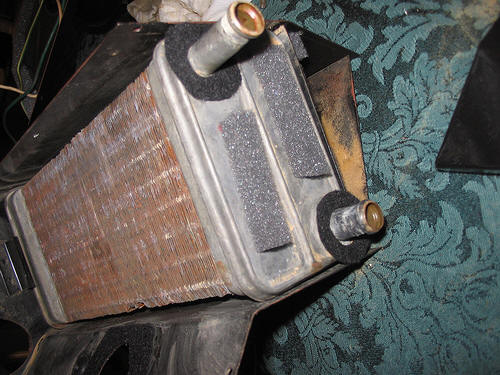
I used black foam
weatherstripping at both ends of the core to minimise rattles. I cut new soft
washers from felt for the pipes. I also used weatherstripping to replace the
perished original seals at various places throughout the box. Here's the next
piece assembled on the box:
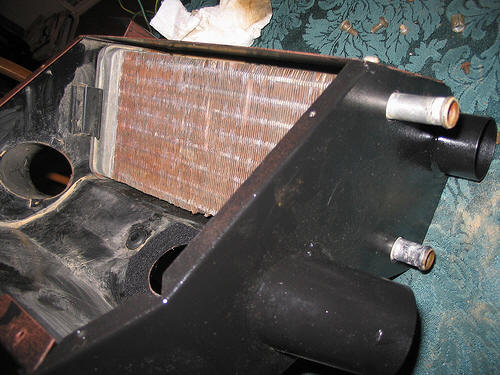
Here's the top cover, before
attaching the motor, and with fresh weatherstrip:
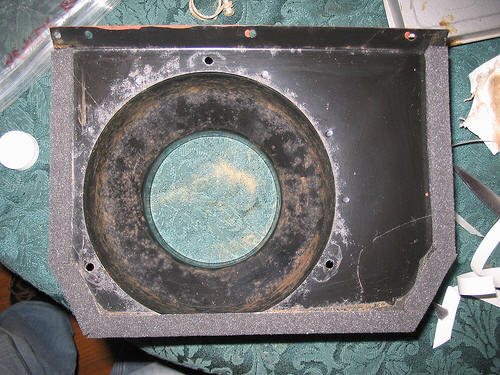
And then with the motor
attached:
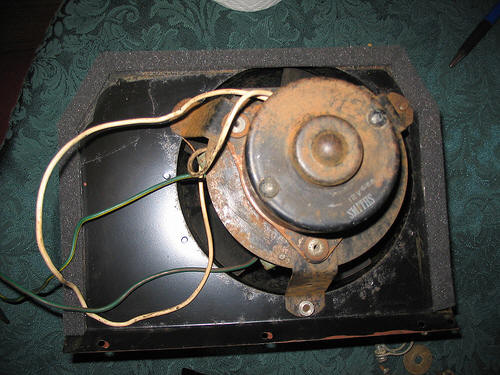
The top cover, about to be
installed on the box: the wires are threaded through a new grommet. A new felt
pad for the base of the motor has been stuck in place, just above the grommet.
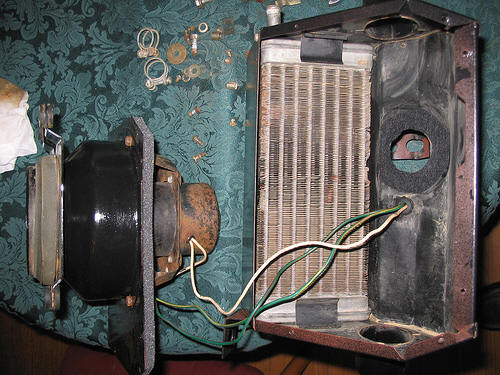
The box completely reassembled,
and with the original decals (carefully removed right at the outset) stuck back
on - but the wrong way up! When reassembling I reused all the original screws -
why buy new ones?
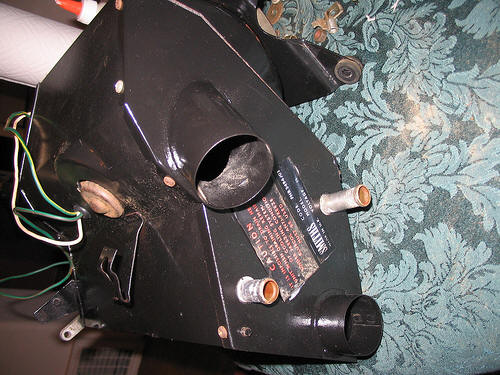
Back to
Overview








